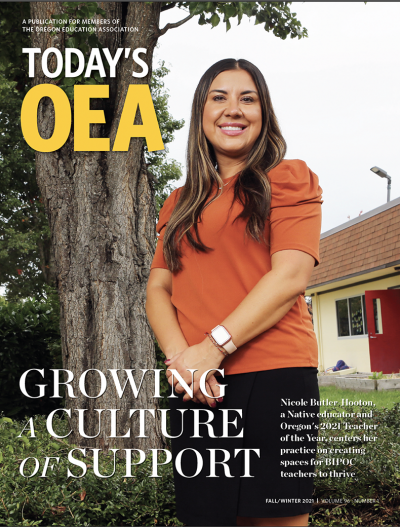"Proceed until apprehended." NEA President Lily Eskelen Garcia quotes this iconic phrase often as she urges NEA member to move forward in their work to improve the lives of their students. It’s a charge many educa- tors embrace when faced with obstacles to doing what they know is right for their schools, their students, and their col- leagues.
It’s also a charge we should embrace as we continue to interpret and understand the Every Student Succeeds Act (ESSA), the most recent reauthorization of the landmark civil rights legislation, the Elementary and Secondary Education Act (ESEA). ESSA returns decision making for our nation’s education back where it belongs – in the hands of local educators, families, and communities.
In effect, ESSA tells educators to indeed proceed until apprehended. We know ESSA provides educators the opportunity we’ve been asking for – educator voice in local school and district decision-making. Moving from that charge to reality though is hard work, but work we believe is worth doing and that will ultimately bene t our students in immeasurable ways.
OEA has been working on a series of tools available at www.oregoned.org/essa to support members in this important work. This article will look at why it’s vital for educators to seize this historic opportunity and provide ideas for how to get started.
“You may encounter many defeats, but you must not be defeated. In fact, it may be necessary to encounter defeats, so you can know who you are.”
— Maya Angelou
Rekindling the Revolution
When President Lyndon B. Johnson signed the ESEA into law in 1965, he said, “And we rekindle the revolution – the revolution of the spirit against the tyranny of ignorance.”
“For too long, political acrimony held up our progress. For too long, children suffered while jarring interests caused stale- mate in the efforts to improve our schools.” (source: Johnson’s Remarks on Signing the Elementary and Secondary Education Act, Johnson City, Texas, April 11, 1965)
These words, spoken by President Johnson more than 50 years ago as he sat next to his own childhood teacher, continue to ring true today. With the disappointing confirmation of Betsy DeVos as U.S. Secretary of Education, educators need to pick up the charge and original intent of the Elementary and Secondary Education Act. Now more than ever, we must step up to advocate for the schools our students deserve in order to protect them from outside threats.
"A lot of people are afraid to say what they want. That’s why they don’t get what they want."
— Madonna
Taking Bold Action
To realize the opportunities in ESSA and protect public education, educators must claim their power and take bold actions at the local level. There are numerous opportunities where educator voice is enshrined in the new law, meaning school districts and the Oregon Department of Education are obligated to include educators in making key decisions about improving schools, teaching and learning, and implementing and monitoring those improvement actions.
Some of the key places where educators are guaranteed a voice include:
- Writing school Title I plans and determining how Title I money is spent at the district and the school level;
- Making decisions about professional development and how Title II funds are spent to support the professional growth of educators in a district;
- Leading and implementing school improvement plans for schools identified for comprehensive or targeted support and improvement (currently today’s priority and focus schools);
- Supporting English learners and their families; and more.
Educators have the right to have a voice in these decisions and should be bold in seeking out avenues to not only give input but to collaborate with school and district leaders in a meaningful way. Even more, when avenues don’t exist for input, OEA is here to help educators create the space to raise their voices.
Educators have the right to demand a voice in these decisions and should be bold in seeking out avenues not only to give input but to collaborate with school and district leaders in a meaningful way. Even more, when avenues don’t exist for input, educators can create the space to raise their voices.
“If you doubt you can accomplish something, then you can’t accomplish
it. You have to have con dence in your ability and then be tough enough to follow through.”
— Rosalynn Carter
The first step to seizing the power educators have under the law is to get educated about ESSA. The Oregon Education Association has a website devoted to helping all our members and the rest of the public understand the law. Visit www.oregoned.org/essa to access a wide variety of informational items, blog posts and other resources to help you, your colleagues, and your school leaders learn about the legislation. NEA also has a wide array of resources available at www.getessaright.org.
The second step to seizing your power is to get organized. In addition to informational resources, OEA has put together a local organizing toolkit to help local associations take steps to learn about ESSA, decide on local priorities, and take action to improve your schools. These tools are designed to assist educators in building the capacity to ensure the implementation of ESSA lifts the voice of educators to build the schools our students deserve.
The toolkit includes:
- Sample agendas for local ESSA teams;
- Tools to conduct opportunity audits;
- Action planning templates and examples;
- And informational resources.
The toolkit is intended to give teams the confidence they need to follow through on accomplishing their goals of taking back local decision making for their schools and classrooms.
“The most common way people give up their power is by thinking they don’t have any."
— Alice Walker
Overcoming Obstacles
One major obstacle educators elevate is that their school and district leaders aren’t interested in talking about ESSA. This is an obstacle we must work around. Educators do not need permission from school leaders to talk about improving teaching and learning in their schools. Indeed, this is what teacher leadership is about.
Let’s take a lesson from the Measure 97 campaign. Despite the defeat of the measure, educators and other activists around the state succeeded in changing the narrative about school funding and corporate taxes. Oregonians now know our state has the lowest corporate taxes in the nation. That is a fact legislators, other policy makers, the public, and corporations now are forced to address.
Educators can change the narrative about who leads improvement efforts, too. Educator voices are strong, loud, and forceful. By forming a local ESSA team, using the tools to identify opportunities or a lack of opportunities, and by engaging your community and families, you can change the narrative in your district.
You can let everyone know that it’s up to educators, families and communities to make key decisions about improving our schools. Those decisions can no longer be made in isolation by superintendents, school board members, or state leaders.
“The question isn’t who is going to let me; it’s who is going to stop me.”
— Ayn Rand
Opportunity Knocking
We know another obstacle educators
face this year is funding. The projected
shortfall in the education budget makes
conversations about improving schools
more difficult. But, the hard conversations
about how to spend limited resources also
presents an opportunity for educators to
elevate the spending priorities that will
make the biggest difference for students.
A local team can start this conversation by conducting an opportunity audit. The Opportunity Dashboard is a list of 25 indi- cators of student success, quality educators, and quality schools identified by NEA during the push to authorize ESSA. The list of indicators includes:
- Access to fully qualified school librarians or media specialists;
- Access to high-quality early education programs;
- Appropriate assessment systems;
- Access to qualified instructional assistants;
- School climate and safe school facilities; and more.
The OEA local organizing toolkit includes tools for local teams to conduct an audit using the Opportunity Dashboard and readily available public data about their schools and districts. Through the audit, a local team can identify where their schools or districts are measuring up and where they are falling short. It can also help shape conversations about where to target resources like federal Title money. Remember, because of ESSA, educators have a say in how those federal funds are spent.
“Destiny is a name often given in retrospect to choices that had dramatic consequences."
— J.K. Rowling
Work Worth Doing
Educators are charged with a weighty mission. They educate, care for, and prepare all students, regardless of their zip code, background, or challenges. Supporting this mission was the intent of the Elementary and Secondary Education Act.
Unfortunately, for the past 15 years, No Child Left Behind made this mission more difficult by narrowly defining school and student success, focusing on math and reading to the detriment of the whole child, and using one-size-fits-all approaches to school improvement.
ESSA swings the pendulum back. It reduces the power of the federal U.S. Department of Education, returning control to states, districts, and schools. Now is the time for all of us to roll up our sleeves and take advantage of the opportunity ESSA provides, the exact opportunity that has eluded educators throughout the reign of NCLB.
As Theodore Roosevelt famously said, “Far and away, the best prize that life o ers is the chance to work hard at work worth doing.” We believe advocating for the schools our students deserve is the work worth doing.

